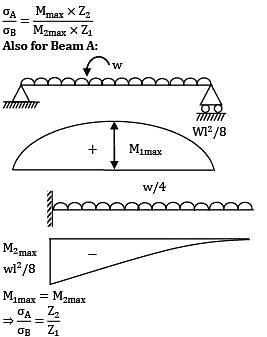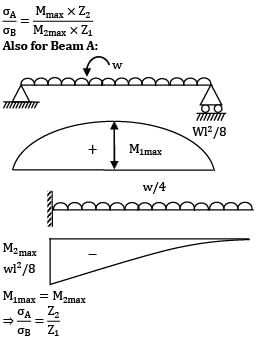Mechanical Engineering Exam > Mechanical Engineering Questions > Beam A is simply supported at its end and ca...
Start Learning for Free
Beam A is simply supported at its end and carries UDL of intensity ‘w’ over its entire length. It is made of steel having Young’s Modulus E. Beam B is cantilever and carries a UDL of intensity w/4 over its length. It is made of brass having young’s modulus E/2. The two beams are of the same length and have the same cross-sectional area. If σA and σB denote the maximum bending stresses developed in beams A and B, respectively, then which one of the following is correct?
- a)

- b)

- c)

- d)

Correct answer is option 'D'. Can you explain this answer?
Verified Answer
Beam A is simply supported at its end and carries UDL of intensity ‘w...
Bending stress in a beam is given by

View all questions of this test
σ = My / I
σ = M / Z
Where Z is section modulus For beams with the same cross section, Z is the same. It is given that the cross sectional area is the same. We cannot infer that Z is same


Since, Z1 and Z2 depends on shape of cross section, hence σA / σB also depends on shape of
cross section.
Most Upvoted Answer
Beam A is simply supported at its end and carries UDL of intensity ‘w...
Bending stress in a beam is given by

σ = My / I
σ = M / Z
Where Z is section modulus For beams with the same cross section, Z is the same. It is given that the cross sectional area is the same. We cannot infer that Z is same


Since, Z1 and Z2 depends on shape of cross section, hence σA / σB also depends on shape of
cross section.

|
Explore Courses for Mechanical Engineering exam
|

|
Similar Mechanical Engineering Doubts
Beam A is simply supported at its end and carries UDL of intensity ‘w’ over its entire length. It is made of steel having Young’s Modulus E. Beam B is cantilever and carries a UDL of intensity w/4 over its length. It is made of brass having young’s modulus E/2. The two beams are of the same length and have the same cross-sectional area. If σA and σB denote the maximum bending stresses developed in beams A and B, respectively, then which one of the following is correct?a) b) c) d) Correct answer is option 'D'. Can you explain this answer?
Question Description
Beam A is simply supported at its end and carries UDL of intensity ‘w’ over its entire length. It is made of steel having Young’s Modulus E. Beam B is cantilever and carries a UDL of intensity w/4 over its length. It is made of brass having young’s modulus E/2. The two beams are of the same length and have the same cross-sectional area. If σA and σB denote the maximum bending stresses developed in beams A and B, respectively, then which one of the following is correct?a) b) c) d) Correct answer is option 'D'. Can you explain this answer? for Mechanical Engineering 2025 is part of Mechanical Engineering preparation. The Question and answers have been prepared according to the Mechanical Engineering exam syllabus. Information about Beam A is simply supported at its end and carries UDL of intensity ‘w’ over its entire length. It is made of steel having Young’s Modulus E. Beam B is cantilever and carries a UDL of intensity w/4 over its length. It is made of brass having young’s modulus E/2. The two beams are of the same length and have the same cross-sectional area. If σA and σB denote the maximum bending stresses developed in beams A and B, respectively, then which one of the following is correct?a) b) c) d) Correct answer is option 'D'. Can you explain this answer? covers all topics & solutions for Mechanical Engineering 2025 Exam. Find important definitions, questions, meanings, examples, exercises and tests below for Beam A is simply supported at its end and carries UDL of intensity ‘w’ over its entire length. It is made of steel having Young’s Modulus E. Beam B is cantilever and carries a UDL of intensity w/4 over its length. It is made of brass having young’s modulus E/2. The two beams are of the same length and have the same cross-sectional area. If σA and σB denote the maximum bending stresses developed in beams A and B, respectively, then which one of the following is correct?a) b) c) d) Correct answer is option 'D'. Can you explain this answer?.
Beam A is simply supported at its end and carries UDL of intensity ‘w’ over its entire length. It is made of steel having Young’s Modulus E. Beam B is cantilever and carries a UDL of intensity w/4 over its length. It is made of brass having young’s modulus E/2. The two beams are of the same length and have the same cross-sectional area. If σA and σB denote the maximum bending stresses developed in beams A and B, respectively, then which one of the following is correct?a) b) c) d) Correct answer is option 'D'. Can you explain this answer? for Mechanical Engineering 2025 is part of Mechanical Engineering preparation. The Question and answers have been prepared according to the Mechanical Engineering exam syllabus. Information about Beam A is simply supported at its end and carries UDL of intensity ‘w’ over its entire length. It is made of steel having Young’s Modulus E. Beam B is cantilever and carries a UDL of intensity w/4 over its length. It is made of brass having young’s modulus E/2. The two beams are of the same length and have the same cross-sectional area. If σA and σB denote the maximum bending stresses developed in beams A and B, respectively, then which one of the following is correct?a) b) c) d) Correct answer is option 'D'. Can you explain this answer? covers all topics & solutions for Mechanical Engineering 2025 Exam. Find important definitions, questions, meanings, examples, exercises and tests below for Beam A is simply supported at its end and carries UDL of intensity ‘w’ over its entire length. It is made of steel having Young’s Modulus E. Beam B is cantilever and carries a UDL of intensity w/4 over its length. It is made of brass having young’s modulus E/2. The two beams are of the same length and have the same cross-sectional area. If σA and σB denote the maximum bending stresses developed in beams A and B, respectively, then which one of the following is correct?a) b) c) d) Correct answer is option 'D'. Can you explain this answer?.
Solutions for Beam A is simply supported at its end and carries UDL of intensity ‘w’ over its entire length. It is made of steel having Young’s Modulus E. Beam B is cantilever and carries a UDL of intensity w/4 over its length. It is made of brass having young’s modulus E/2. The two beams are of the same length and have the same cross-sectional area. If σA and σB denote the maximum bending stresses developed in beams A and B, respectively, then which one of the following is correct?a) b) c) d) Correct answer is option 'D'. Can you explain this answer? in English & in Hindi are available as part of our courses for Mechanical Engineering.
Download more important topics, notes, lectures and mock test series for Mechanical Engineering Exam by signing up for free.
Here you can find the meaning of Beam A is simply supported at its end and carries UDL of intensity ‘w’ over its entire length. It is made of steel having Young’s Modulus E. Beam B is cantilever and carries a UDL of intensity w/4 over its length. It is made of brass having young’s modulus E/2. The two beams are of the same length and have the same cross-sectional area. If σA and σB denote the maximum bending stresses developed in beams A and B, respectively, then which one of the following is correct?a) b) c) d) Correct answer is option 'D'. Can you explain this answer? defined & explained in the simplest way possible. Besides giving the explanation of
Beam A is simply supported at its end and carries UDL of intensity ‘w’ over its entire length. It is made of steel having Young’s Modulus E. Beam B is cantilever and carries a UDL of intensity w/4 over its length. It is made of brass having young’s modulus E/2. The two beams are of the same length and have the same cross-sectional area. If σA and σB denote the maximum bending stresses developed in beams A and B, respectively, then which one of the following is correct?a) b) c) d) Correct answer is option 'D'. Can you explain this answer?, a detailed solution for Beam A is simply supported at its end and carries UDL of intensity ‘w’ over its entire length. It is made of steel having Young’s Modulus E. Beam B is cantilever and carries a UDL of intensity w/4 over its length. It is made of brass having young’s modulus E/2. The two beams are of the same length and have the same cross-sectional area. If σA and σB denote the maximum bending stresses developed in beams A and B, respectively, then which one of the following is correct?a) b) c) d) Correct answer is option 'D'. Can you explain this answer? has been provided alongside types of Beam A is simply supported at its end and carries UDL of intensity ‘w’ over its entire length. It is made of steel having Young’s Modulus E. Beam B is cantilever and carries a UDL of intensity w/4 over its length. It is made of brass having young’s modulus E/2. The two beams are of the same length and have the same cross-sectional area. If σA and σB denote the maximum bending stresses developed in beams A and B, respectively, then which one of the following is correct?a) b) c) d) Correct answer is option 'D'. Can you explain this answer? theory, EduRev gives you an
ample number of questions to practice Beam A is simply supported at its end and carries UDL of intensity ‘w’ over its entire length. It is made of steel having Young’s Modulus E. Beam B is cantilever and carries a UDL of intensity w/4 over its length. It is made of brass having young’s modulus E/2. The two beams are of the same length and have the same cross-sectional area. If σA and σB denote the maximum bending stresses developed in beams A and B, respectively, then which one of the following is correct?a) b) c) d) Correct answer is option 'D'. Can you explain this answer? tests, examples and also practice Mechanical Engineering tests.

|
Explore Courses for Mechanical Engineering exam
|

|
Signup for Free!
Signup to see your scores go up within 7 days! Learn & Practice with 1000+ FREE Notes, Videos & Tests.


























